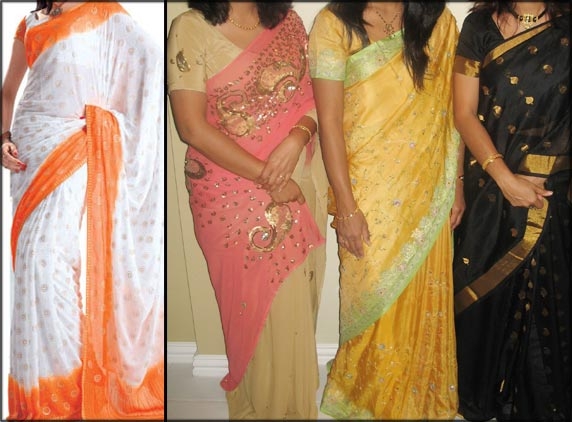
Saree-traditional Indian dress worn by Hindu women-six yards long as a rule; Vedic women's dress.By adopting a Vedic tradition such as wearing a saree, one also adopts, to some degree, the culture as well.
The more society strays from Vedic culture, the more its dress becomes degraded followed by illicit sex, divorce and abortion, etc.By abandoning the safe and culturally-chaste sari in favor of other attire, we risk falling back into the godless pits of sense gratification.
The Lord's female counterpart, Srimate Radharani, sets the eternal example by wearing beautiful sarees for pleasing Her Lord.
"After Her midday bath, Radharani takes another bath in the nectar of bodily luster, and She puts on the garment of shyness, which is Her black silk saree.(Caitanya Caritamrta; Madhya 8.168)
When women wear sarees they make a statement in favor of chastity. Sarees are modest compared to Western-style attire which often aims at inciting lusty desires.
Now of course we see celebrities in India wearing a sari in a very unchaste manner but that is not recommended by our Hindu culture.
The sari is the traditional outfit of Indian women. This outfit is probably the oldest attire ever invented in India and to date proclaims to be the most beautiful yet comfortable; most enchanting yet well-ordered outfit.
Those who are new to this Indian garb would probably be baffled if they knew that there are actually a zillion ways to drape this six-yard material around oneself. Each community in India has its own style and method of wearing the sari. But whichever way it is worn, the traditional belief that "the sari is the sentry of a woman's dignity" has been the underlying motive for its creation.
In the olden days, the sari was adorned by women upon reaching puberty. It was believed that the sari was the ideal attire to camouflage their body assets. The respect given to this attire was remarkable. Our forefathers and fore mothers used to be even picky about the way the sari was worn by women. The blouse worn in parallel to the sari had to be decently stitched. The sari too had to be respectably draped around the body without showing off too much of flesh - be it at the waist, back or legs. The older folks considered these body parts to be the most alluring for men. That was the whole point about wearing a sari as opposed to wearing a normal top and a skirt below - to deter men or strangers from ogling at women.
However, over the centuries, the sari has gradually gone through immense transformations and modifications thanks to the advent of fashion. Today, you see the sari being worn in different manners by women all over the world. Some deliberately drape the sari to show off their waist, chest area and back. As such, the traditional significance of the sari these days, I feel, has diminished. Have a look at some of the Indian movies of today. The heroines often drape the sari in many fashionable and revealing ways and so have influenced the women of today.
In conclusion, all I can say is that there could be a thousand ways to drape a sari, but the underlying traditional principle of wearing it should not be discounted or reduced in the name of modern culture.
Hope you would get inspired and surprise others by wearing a sari, the next morning...
















